Since 1969, the U.S. Army Medical Research Institute of Infectious Diseases (USAMRIID) at Fort Detrick, Md., has been using science and technology to address biological threats to U.S. military personnel.
“While it’s an Army lab, within the DoD construct, a lot of the research that goes on here has wider applicability that protects the American public,” said Col. E. Darrin Cox, M.D., USAMRIID’s former commander. “Our specialty, or our core competency, lies in high-consequence pathogens,” Cox said.
“We’ve maintained our core mission of developing medical countermeasures against those high-consequence pathogens,” Cox said. “Certainly, COVID is a high-consequence pathogen from the standpoint of the havoc it’s wreaking on the healthcare of the nation and the world, and economically.”
John M. Dye, Jr., Ph.D., is a viral immunologist with USAMRIID. His work has focused on filovirus vaccines and therapeutics, with years of intense research to combat Ebola and related viruses.
“Our specific goal is to develop medical countermeasures, vaccines and treatments, for emerging infectious diseases and potential bio-threats,” Dye said. “There’s a wide range of infectious pathogens that could potentially be used by a nefarious agent.”
Dye’s Ebola research efforts have given him the opportunity to lead teams throughout Africa, Central and South America to track immune response in hundreds of survivors of this and other diseases.

“A lot of the treatments that we develop here for the soldier, and the soldier’s family, actually make it out into the larger world and help humanity as an entirety,” Dye said.
USAMRIID leadership continues to look to the future and is opening doors for the next generation of medical researchers to support the nation. “We’re always building the bench for the future, and we have a number of programs that bring in young researchers,” Cox said.
He said there are programs to inspire talent across the gamut, from high school through post-doctoral research.
“Some of them are sponsored by outside agencies and some of them are sponsored internally, and then those folks have an opportunity to spend anywhere from three to five years here, in their post-doctoral time, and then either move on or stay here,” Cox said. “We have a developmental program to have a junior researcher turn into a senior researcher turn into a primary investigator.”
“We’re always looking for programs that bring in young folks to be the next year’s leaders, the future leaders of this research,” added Cox.
One such rising star in USAMRIID’s civilian cadre is Keersten M. Ricks, Ph.D., a research microbiologist within the diagnostic systems division. She came to USAMRIID after earning her doctorate of chemistry at Vanderbilt University, in Nashville, Tennessee.
She was immediately welcomed to the team and found a collaborative partner and mentor in Dye.
“John (Dye) is not only an incredible scientist in and of himself, but he’s a huge advocate for advancing the careers of young scientists,” Ricks said. “It can be hard as an early career Ph.D. scientist finding your way in a large research institute such as USAMRIID. John has been so helpful to me in my career here with giving me advice and being willing to collaborate on some of my ideas for diagnostic tool development.”
Dye continues to look to the future and understands the importance of his role to help ensure the Army maintains an effective research capability and long-term subject matter expertise.
“This was a perfect opportunity,” Dye said, “to become a civilian employee, at a military installation, where I could take what I learned in graduate school, in infectious disease and immunology and virology, and help apply it to the military, the United States Army, and the world in general.”
As he departed the USAMRIID, earlier this month, Cox paid tribute to the USAMRIID workforce. He said he continued to be impressed by their intellect, devotion to the mission, and ability to handle multiple tasks while staying on point.
“You are taking command of a storied organization filled with wonderful people who are making a difference every day,” Cox told Col. Constance L. Jenkins, his successor as USAMRIID commander. “I have no doubt you will take this organization to even higher heights and greater successes.”
Adapted from original by Phil Fountain, U.S. Army Futures Command.



